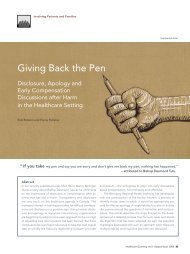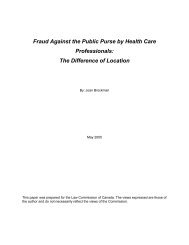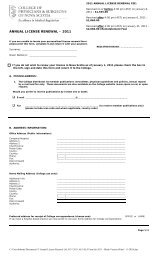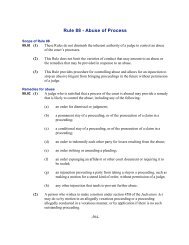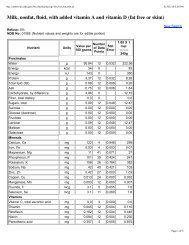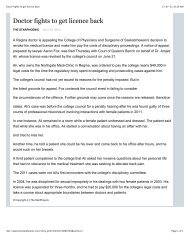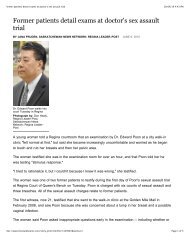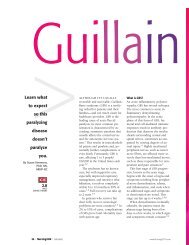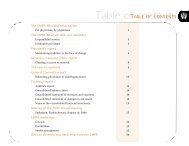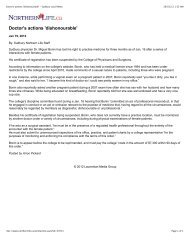Experiments That Changed Nutritional Thinking - TUUM EST
Experiments That Changed Nutritional Thinking - TUUM EST
Experiments That Changed Nutritional Thinking - TUUM EST
You also want an ePaper? Increase the reach of your titles
YUMPU automatically turns print PDFs into web optimized ePapers that Google loves.
1036S<br />
SUPPLEMENT<br />
important, because this assay validated the other assays. No<br />
data were available on the ‘‘form in which Cu occurs in liver’’<br />
or on ‘‘various materials’’ in which chemical form may have<br />
a ‘‘modifying effect upon the action of Cu.’’ These comments<br />
are valid in regard to much recent work on the biology of<br />
copper, as well.<br />
Literature Cited<br />
Allen, F. L. (1931) Only Yesterday, p. 160. Harper and Brothers Publishers,<br />
New York, NY.<br />
Allen, K.G.D. & Klevay, L. M. (1978) Cholesterolemia and cardiovascular abnormalities<br />
in rats caused by copper deficiency. Atherosclerosis 29: 81–93.<br />
Bennetts, H. W., Harley, R. & Evans, S. T. (1942) Studies on copper deficiency<br />
of cattle: the fatal termination (‘‘falling disease’’). Aust. Vet. J. 18: 50–63.<br />
Cohn, E. J., Minot, G. R., Fulton, J. F., Ulrichs, H. F., Sargent, F. C., Weare, J. H. &<br />
Murphy, W. P. (1927) The nature of the material in liver effective in pernicious<br />
anemia. I. J. Biol. Chem. 74: 1xix–1xxii.<br />
Funk, C. (1912) The etiology of the deficiency diseases. J. State. Med. 20:<br />
341–368.<br />
Hart, E. B., Steenbock, H., Waddell, J. & Elvehjem, C. A. (1928) Iron in nutrition.<br />
VII. Copper as a supplement to iron for hemoglobin building in the rat. J. Biol.<br />
Chem. 77: 797–812.<br />
Hill, A. B. (1965) The environment and disease: association or causation? Proc.<br />
R. Soc. Med. 58: 295–300.<br />
Hopkins, F. G. (1906) The analyst and the medical man. Analyst 31: 385–404.<br />
Keil, H. L. & Nelson, V. E. (1934) The rôle of copper in carbohydrate metabolism.<br />
J. Biol. Chem. 106: 343–349.<br />
FIGURE 2 Modified from chart V (Hart et al. 1928). Klevay, L. M. (1973) Hypercholesterolemia in rats produced by an increase in<br />
the ratio of zinc to copper ingested. Am. J. Clin. Nutr. 26: 1060–1068.<br />
Klevay, L. M. (1987) Dietary requirements for trace elements in humans. In:<br />
measuring hemoglobin was not among them. Copper in the<br />
Trace Element-Analytical Chemistry in Medicine and Biology (Brätter, P. &<br />
liver preparation was measured by the xanthate method with-<br />
Schramel, P., eds.), pp. 43–60. Walter de Gruyter & Co, Berlin, Germany.<br />
out citation. Inspection of papers I, V, IV and VI in their Lei, K. Y. & Carr, T. P. (1990) Role of Copper in Lipid Metabolism, CRC Press,<br />
Boca Raton, FL.<br />
series revealed no method of iron analysis. Hemoglobin was<br />
McCollum, E. V. (1957) A History of Nutrition. Houghton Mifflin, Boston, MA.<br />
measured with either Feischl-Miescher or Newcomer hemoglo- Osler, W. & McCrae, T. (1926) The Principles and Practice of Medicine, 10th<br />
binometers, methods not likely to be as reliable as the cyan-<br />
ed. D. Appleton and Company, New York, NY.<br />
Percival, S. S. (1995) Neutropenia caused by copper deficiency: possible<br />
methemoglobin method. Similarly, it is not clear which of the<br />
mechanisms of action. Nutr. Rev. 53: 59–66.<br />
Cohn fractions was used. Two were active in treatment of Schultze, M. O. (1939) The effect of deficiencies in copper and iron on the<br />
pernicious anemia; another contained a ‘‘substance capable of<br />
cytochrome oxidase of rat tissues. J. Biol. Chem. 129: 729–737.<br />
Shields, G. S., Coulson, W. F., Kimball, D. A., Cartwright, G. E. & Winthrobe, M.<br />
reducing blood pressure.’’ One can infer (Schultze 1939) that<br />
(1962) Studies on copper metabolism XXXII. Cardiovascular lesions in copcages<br />
were made of galvanized iron. per deficient swine. Am. J. Pathol. 41: 603–621.<br />
<strong>Nutritional</strong> scientists became preoccupied with the hematice-Hall,<br />
Sorum, C. H. (1949) Introduction to Semimicro Qualitative Analysis, p. 5. Prentology<br />
New York, NY.<br />
of copper for more than a half century after this work.<br />
Whipple, G. H., Robscheit, F. S. & Hooper, C. W. (1920) Blood regeneration<br />
The reason for this preoccupation is not clear, but it may have following simple anemia. Am. J. Physiol. 53–54: 236–262.<br />
been created by the vigor of Cartwright and Wintrobe. Perhaps<br />
just as the Buchners’ concepts of cell-free fermentation were<br />
resisted by many because of Pasteur’s experiments on spontaneous<br />
generation, many in nutrition began to think that hematol-<br />
Wintrobe, M. M. (1967) Clinical Hematology, 6th ed. Lea & Febiger, Philadel-<br />
phia, PA.<br />
Paper 11: The Conversion of Carotene<br />
to Vitamin A (Thomas Moore, 1930)<br />
ogy was everything in relation to copper.<br />
A few were more flexible, however, and searched for other<br />
characteristics of copper deficiency. Keil and Nelson (1934) Presented by James Allen Olson, Department of Biochemistry and<br />
discovered what now is called glucose intolerance. Bennetts et Biophysics, Iowa State University, Ames, IA 50011-3260 as part<br />
al. (1942) first noticed cardiac catastrophes. The hematologists of the minisymposium ‘‘<strong>Experiments</strong> <strong>That</strong> <strong>Changed</strong> <strong>Nutritional</strong><br />
were not totally inactive in this latter field (Shields et al. <strong>Thinking</strong>’’ given at Experimental Biology 96, April 16, 1996, in<br />
1962). Surely if the hypercholesterolemia of copper deficiency Washington, DC.<br />
were not nearly invisible in plasma or serum (in contrast to<br />
hypertriglyceridemia, which is mild in deficiency), copper and In the early 1900s, Frederick Gowland Hopkins, Casimir<br />
lipid metabolism would have been associated long before 1973 Funk and others realized that minor organic components of<br />
(Klevay). Now (Lei and Carr 1990) there is much more re- foods played essential roles in growth and nutritional wellbeing.<br />
search being published on cardiovascular effects of copper deficiency<br />
These minor essential constituents of the diet were<br />
than on hematology, although interest in the latter is termed ‘‘vitamines,’’ primarily because the first one discovered,<br />
reviving with a shift toward leukocytes (Percival 1995). It may thiamine, clearly possessed an amine function. <strong>That</strong> these mys-<br />
be interesting to know what pathology might have been found terious vitamines were present not only in water-soluble extracts<br />
by Hart et al. (1928) with even limited necroscopy. Sometimes<br />
of living materials but also in fat-soluble extracts was<br />
pathology is obvious (Allen and Klevay 1978).<br />
soon noted by several investigators both in the United States<br />
Hart et al. (1928) commented that ‘‘Only when some important<br />
and in Europe. McCollum and Davis (1913) at the University<br />
function . . . lends itself . . . to quantitative measure- of Wisconsin and Osborne and Mendel (1913) at Yale Univer-<br />
ment are conditions suitable for making progress . . . .’’ They sity first identified foods containing this fat-soluble growth<br />
had adequate methods for measuring copper, hemoglobin, etc., factor. Active foods included butter, egg yolk, whole milk<br />
but the bioassay using rat 621 and others perhaps was most powder, cod liver oil and many pigmented fruits and vegeta-<br />
/ 4p09$$0062 04-07-97 14:02:12 nutras LP: J Nut May Suppl<br />
Downloaded from jn.nutrition.org by on June 3, 2010



